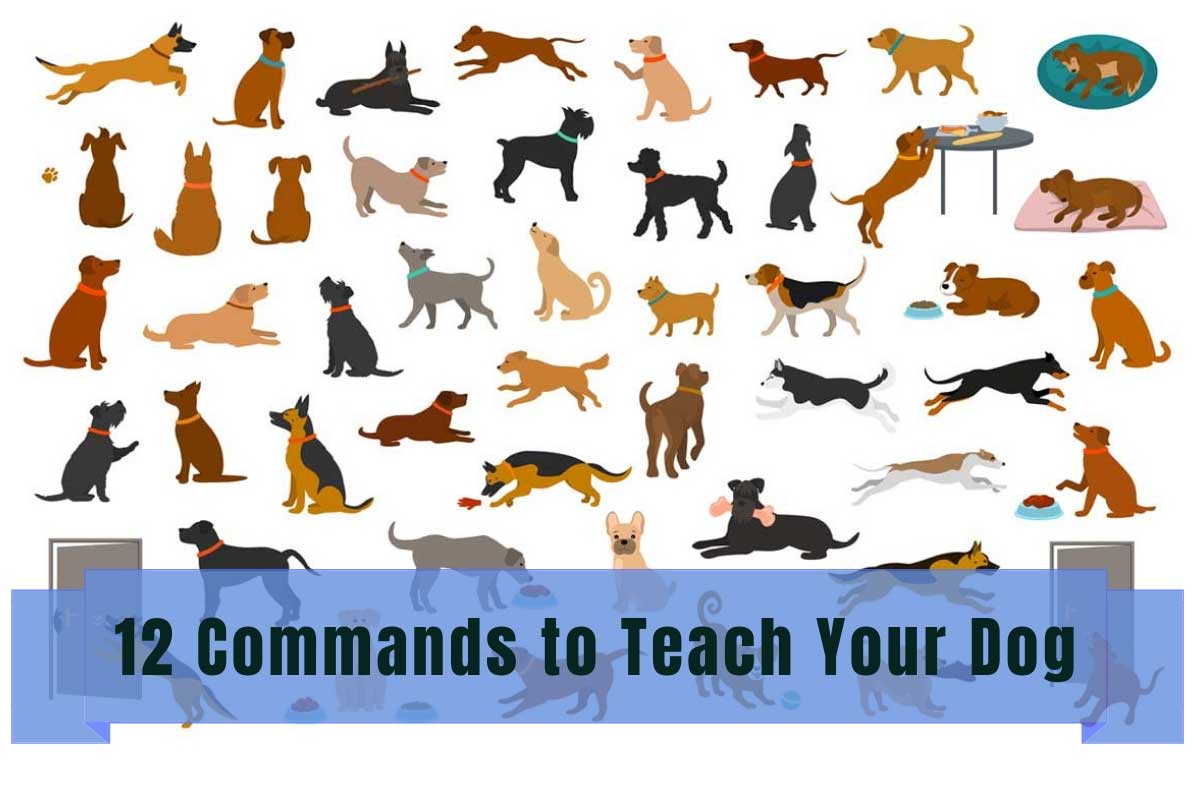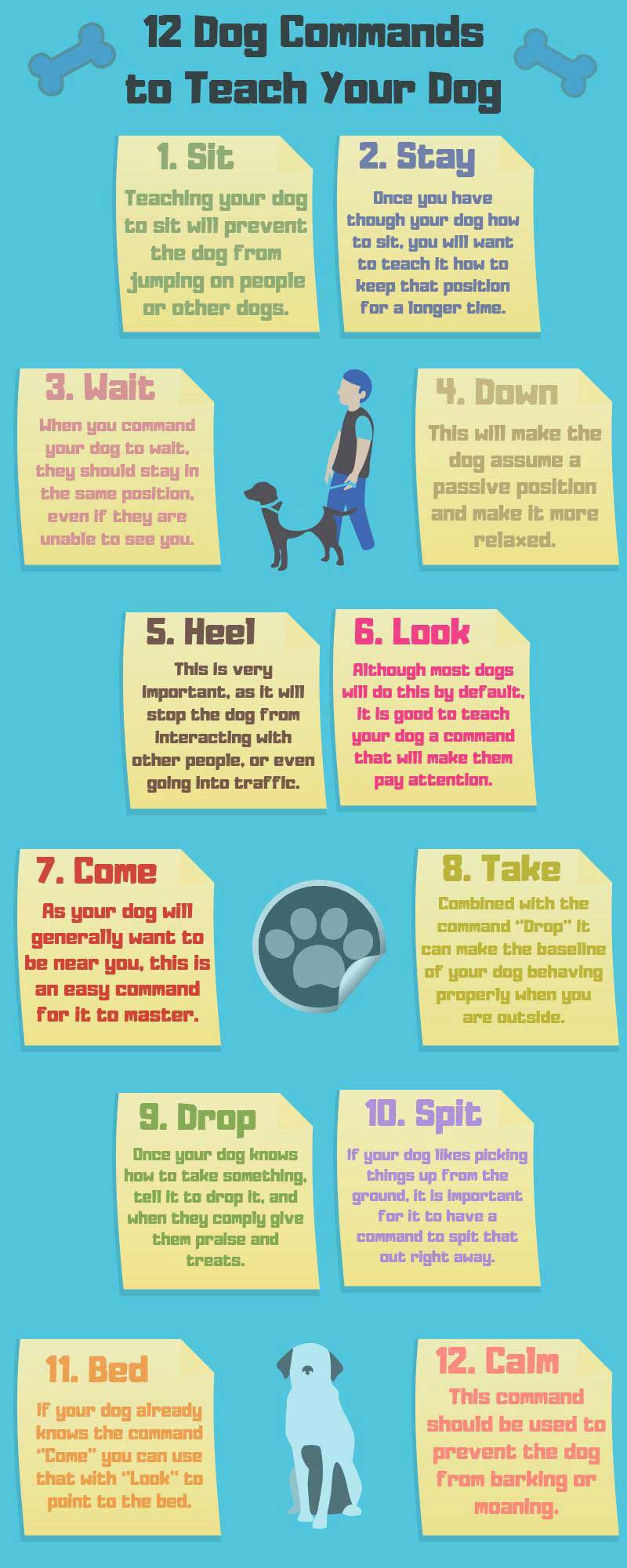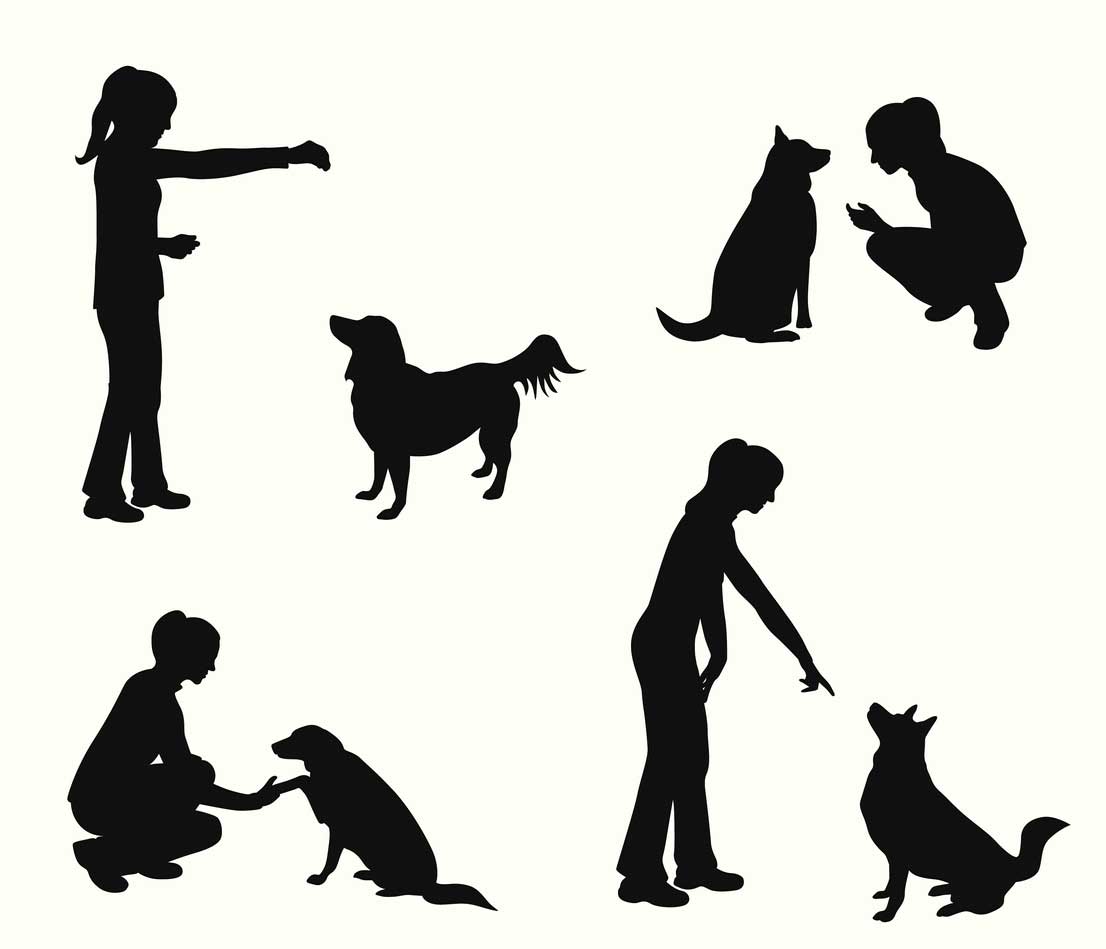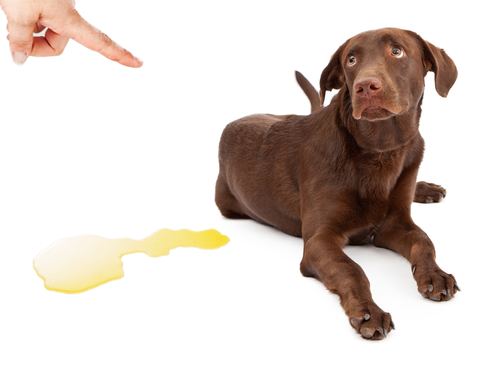Does it sometimes feel like your dog can understand everything that you are saying? If so, it is because they (almost) can. It’s not that dogs speak our language or can read our lips, but they most certainly can understand certain commands due to the tone and vibrations in your voice, how loud you speak, how you gesticulate, and the odd hand signal, as well as the fact that they can remember actions practiced. Using the “command” technique correctly, there are multiple dog commands that you will be able to teach your canine companion.
To make your dog understand exactly what you want him to do each time, there are few things you have to practice. First of all, dog training should always start with basic obedience. After that, it is important that you stick to the same commands and don’t change the words or tone of the command. If you do this correctly, over time your dog will be able to react toyour commands.
Contents
InfoGraphic
What Are Dog Commands?
Dog training commands are short, simple words that are meant to inform the dog that you want something from them. Unlike people, dogs don’t understand the meanings behind the commands, but rather the intent. Your intent is not only made with the sound with each verbal cue but also the emotion you place on the command.
These actions are reinforced through repetition and once they are understood by the dog, they will obey every time. The only important thing is that each cue is simple, short, and direct. This simplicity will not only allow the dog to better remember and more easily recognize the words, but it will also help you pronounce the verbal command, in the same way, every time.
How to Train Your Dog to Obey Dog Commands
The name of the game is positive reinforcement. If you start at a very early age, you will be able to train your dog to obey more than half of the commands (listed below) while it is still a puppy.
Contrary to popular belief, a dog’s intelligence isn’t the key when it comes to training. While a smarter breed may learn commands faster, dogs of average intelligence will become more focused while learning. In many ways, this is the same school of thought for humans.
Like with clicker training, dog trainers will always tell you that the best way to train your furry friend is to use a treat of some kind and make the dog follow an action. For instance, if you want your dog to sit, keep the treat in your hand and give the command. After a certain amount of time, they will learn to sit but may stand up when you give them the food. If they do this, pull back your hand and repeat the cue. Once the dog is sitting calmly, give it the treat as a reward and you are on your way to a well-behaved dog.
As you give the dog training commands, you need to reduce the number of treats you give your dog as you progress. However, you still need to reward your dog each time he does something correctly. This could be a verbal reward, such as saying “good dog” or a physical reward such as a pat on the head or a tickle of the ears.
Command Tones
Always remember to keep your tone the same when making a command. This means that the command should be at the tone and volume you prefer. There is no need to yell or to speak loudly to dogs as they are like young children—just use your normal voice, mixed with a little enthusiasm. If you shout, you will scare them and they won’t do what you command.
As you will be using different commands in different situations, it may be a good idea to separate them into different tone groups. This will make it easier for you to repeat the same sounding command when you are outside, so it doesn’t confuse your dog.
High Tones
You should use high tones for any command that you may be giving the dog from afar, such as “come,”“spit,”“drop,”and “calm.”High tones travel longer distances without distortion, making it possible to give dog commands to your canine companion even in a crowded area from several feet away.
Medium Tones
Medium tones can be used in most situations, but are best for regular interactions such as “bed,”“heel,”or “look.” These are usually basic commands that you will repeat often; therefore, it is best to start teaching your dog how they sound under normal circumstances.
Base Tones
Base tones should be for calm commands, such as “sit,”“stay,”and“wait.” These tones are good enough to ensure that your dog pays attention. As you will try to sound serious by default when giving these simple commands, it is normal to use the same tones by default when outside.
“Language” for Commands to Teach Your Dog
Unlike humans, all dogs speak—or rather bark—the same doggy language. The only difference is how we hear those barks depending on your own native language. While it can be tempting to teach a German Shepherd dog commands in German, it wouldn’t serve any practical purpose.
In all seriousness, the best language you can use for your dog commands in is your native language—and in any dialect that you speak. It really doesn’t matter as long as you use the same level, tone, and words each time you give the commands. If you are fluent in different languages you may want to try, say, giving your dog commands in French but speaking to your partner in English. It is up to you, really. Just make sure that you don’t mix the commands between the two languages, as it could confuse your little pup.
Dog Commands
Hypothetically, there is no such thing as a limit to the number of commands can teach your dog. The ones we listed below, however, are the best dog commands that you will probably use in your everyday life—though you can add many more if you wish.
1. Sit
This is one of the primary commands that you should have in your arsenal. Teaching your dog to sit will prevent the dog from jumping on people or other dogs. Additionally, this will teach the dog patience, which is very important for their psychology once they reach adulthood.
*Tip
With a treat in your hand and place it above the dog’s head. Due to their build, they will need to sit as to smell the treat. Once they do, give the command, then them the treat (when they carry out the command), and then comfort the dog. Try doing this exercise from further and further away, until you come to the point that the dog doesn’t need to see the treat as to follow the command.
2. Stay
Once you have taught your dog how to sit, you will want to teach him how to keep that position for longer. This will be useful when you want your dog to wait for you or when you are doing something and you don’t want him to come bounding over. This is also one of the basic training commands that will later be used to teach your dog other tricks. It will also regulate the dog’s behavior.
*Tip
The best way to teach your dog to stay is to make him sit and, once he has sat down, start stepping backward. In the beginning,your dog may stand up to follow you to try and get the treat in your hand, but you need to stop him. Try again, then repeat once he starts to understand. The goal is for you to be able to move around and do different tasks without him moving a muscle. It may sound impossible now but, with time, it is very much possible—trust me!
Once complete, tell your dog to “break,” reassure and comfort him, and give him a treat.
3. Wait
While sounding fairly similar to the former command, there is one key difference. When you command your dog to wait, he should stay in the same position—even if he is unable to see you. This command will come especially useful when you are walking your dog and you need to go into a 7-Eleven for a snack which doesn’t allow pets. You should be able to command your dog to stay and be confident that he will be waiting for you where you left him without barking, moaning, or pulling at the leash.
*Tip
If your dog knows how to “stay,” start pushing the boundaries by giving the command to wait and then yourself from his field of vision. This should only be for just a few moments at first,but then start making that time longer. This will leave your furry friend feeling reassured that you will be coming back.
4. Down
The usual words for this command are“lay down” but as two words can sometimes confuse the dog; therefore, it is better just to teach him“down.” This will make your dog assume a passive position and ensurehe feelsmore relaxed. This trick will be important as you will often need the dog to follow several commands such as “calm,”“drop,”and “wait” at the same moment—all of which can be done with this one command.
*Tip
If your dog already knows how to sit, you can just placea treat on the ground and in front of him to encouragehim to lie down (but not in a sleeping position). Say the command and show him that he did well. As with sitting, repeat the training until hewill lie down happily without needing a treat, though it is advisable to still offer a little verbal comfort initially.
5. Heel
This is probably a command that you will use most often, though it is fairly difficult to accomplish. It is not quite telling your dog to stop sniffing around on the street, but moreto start following you in lockstep. This is very important, as it will stop the dog from interacting with other people—or even wandering dangerously into traffic. Though it may take a while, you should be able to take your dog for a walk without a leash, as he will know how to behave when he is outside.
*Tip
Always keep your leash loose and in front of you. If Your dog starts pulling to one side, pull the leash upward and give the command. If the dog corrects itself immediately, give him a treat and a little comfort.
6. Look
Although most dogs will do this by default, it is good to teach your dog a command that will make him pay attention. Teaching this at a very early age should make it easier to teach other dog commands, as well as to use gestures when training. Face gestures are often neglected, even though human evolution has created something that is very useful and very rare in nature—the whites of your eyes. You will notice that the dog will often follow your eyes and try to look where you are looking.
*Tip
To teach your dog to look, you can place a treat in your fist and extend your index finger. Make a long, exaggerated, gesture by placing your finger on your nose. Give the command and if your dog is looking at you correctly, comfort him and give hima treat.
7. Come
As your dog will generally want to be near you, it is an easy command for it to master. The use for the command is obvious, as you will need to call back your dog when you are in the park or just need to go somewhere. Additionally, this will recall your dog from any potential conflict with other dogsor cats.
*Tip
Step a few feet away from your dog and gently pull on the leash before giving the command. When the dog comes, give him a treat and a little praise. Then step a little further away and repeat. The command should work without a treat in your hand and possibly without a leash.
8. Take
There are several variations of this command and the one that you will want to use will depend on your preference. “take”is a command for the dog to pick something up. Possible other words for the command are “bring” and “catch.” Combined with the command “drop,” it can make the baseline of your dog’s behavior when you are outside.
*Tip
This command is best done with a ball or similar object that your dog will want to grab in the first place. Give the command and place the object in front of your dog. Once he picks it up, praise him and offer the furry genius a treat in exchange for the object.
9. Drop
One of the more direct commands, teaching your dog to drop something is paramount if you want it to behave properly when you are on a walk or in the park. Not only will this prevent some indiscriminate eating, which can be devastating for his health, it will also reduce the risk of your dog from biting anyone.
*Tip
It is best to practice this command with the last command (number 12), as your dog will be able to drop and pick up the same object multiple times. Once your dog knows how to take something, tell him to drop it, and when he complies give him praise and treats.
10. Spit
This is a significantly more aggressive command than the last one—and for a good reason. If your dog likes picking things up from the ground, it is important for it to have a command to spit that out right away.
A number of pet owners use just a straight “No!” for this command, as this is the first word that will come to you in these situations.
*Tip
Use something like a stick to drop it on the floor so that your dog can see. When he comes to pick it up, give the command, and pick up the stick yourself. If the dog stops, praise him and rewardhim with a treat.
11. Bed
Also given as “place” this is a very good command for your dog to understand. It will come in handy when you have guests coming over who can’t relax around dogs. This will let your dog wait at his bed or inside the crate until everyone relaxes. Also, this can be a good way to tell your dog that it is time to go to sleep—and to do that he has to get off the couch.
*Tip
If your dog already knows the command “come,” you can expand it slightly with “look” to point to the bed. If he jumps right in, praise him and give a treat. If you have not yet mastered former commands, you can always use gentle pulls of the leash.
12. Calm
It is to be expected that any young puppy will become excited every time you are willing to give him attention, especially if he can smell food treats in your hand. The “calm” command should be included in the obedience training. This command should be used to prevent him from barking or whining.
*Tip
Use a clicker, or snap your fingers, to guide the dog to his bed, the rug, or anywhere they feel comfortable. As soon as they reach their destination, give the command“calm” and reward him with a treat. Eventually, he will get to understand what the command means.
Final Thoughts
Dog commands are not just tricks that your dog can do for fun. Most commands help your dog with socializationbetter in both the human world and the dog world. Staying calm and following your lead should be the purpose of his behavior.
While training your dog can be time-consuming and sometimes tiresome, getting him to understand your commands and follow your orders will make you and your dog happier, as you will spend less time yelling and more time playing and cuddling. Now go…and teach your dog these commands!
I grew up in a household that was filled with animals. I believe that my fate as a dog-loving person was sealed in early childhood since my parents owned several dogs of varying sizes and breeds. There was no choice but to take care of and learn about dog habits and the best animal care practices — otherwise, I’d be clueless about how to go about the creatures I was surrounded by day and night.
As a life-long puppy lover, I know a thing or two about dogs and how to go about caring for them in the best way possible. Although I’m not a professionally trained dog behaviorist, trainer, or veterinarian, all of my knowledge and experience with canines comes from a place of love and a deep-rooted passion for dogs and animals in general.
Seeing as dogs kept me company throughout every stage of my life, I decided to follow a different path in my academic life and obtained a Bachelor’s and Master’s degrees in Marketing Management and Digital Advertising, which ultimately allowed me to combine my professional training and personal experience by creating the ultimate dog lover’s resource website! Along with my husband, Dave, I run MySweetPuppy for like-minded dog lovers who want to have a single, clear, and reliable information source about anything and everything related to dogs and their well-being.






